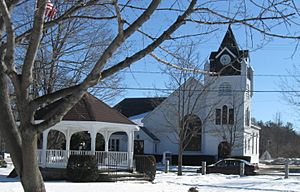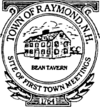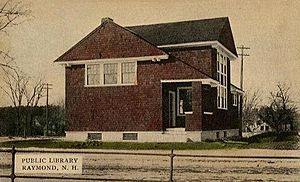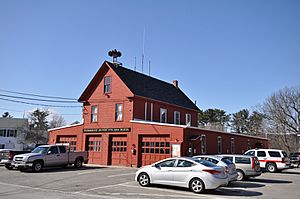Raymond, New Hampshire facts for kids
Quick facts for kids
Raymond, New Hampshire
|
||
|---|---|---|

The Common (Lyman Memorial Park), 2013
|
||
|
||

Location in Rockingham County and the state of New Hampshire.
|
||
| Country | United States | |
| State | New Hampshire | |
| County | Rockingham | |
| Incorporated | 1764 | |
| Area | ||
| • Total | 29.6 sq mi (76.7 km2) | |
| • Land | 28.8 sq mi (74.6 km2) | |
| • Water | 0.8 sq mi (2.1 km2) 2.68% | |
| Elevation | 200 ft (60 m) | |
| Population
(2020)
|
||
| • Total | 10,684 | |
| • Density | 371/sq mi (143.1/km2) | |
| Time zone | UTC-5 (Eastern) | |
| • Summer (DST) | UTC-4 (Eastern) | |
| ZIP code |
03077
|
|
| Area code(s) | 603 | |
| FIPS code | 33-64020 | |
| GNIS feature ID | 0873705 | |
Raymond is a town in Rockingham County, New Hampshire, United States. The population was 10,684 at the 2020 census. Part of Pawtuckaway State Park is in the north.
The main village in town, where 3,738 people resided at the 2020 census, is defined as the Raymond census-designated place (CDP), and is located along the Lamprey River near New Hampshire Route 27.
Contents
History
This town was first settled by families from Exeter as a parish of Chester, and known as Freetown because it was exempt from the usual obligation of reserving its tall pine trees for masts in the Royal English Navy. The town was incorporated in 1764 by Colonial Governor Benning Wentworth.
There are at least two theories regarding the source of the town's name. The earlier theory, stated by Joseph Fullonton in his "History of Raymond," published 1875, is that the name was chosen as "a new and classical one." Fullonton relates that the original name of "Freetown" “arose from the ship timber business” where the king claimed the best trees. The locals had other ideas and took the trees and “being successful here, none ..., they called it Freetown.” Fullonton states that at incorporation in 1764, changing the name from “Freetown” to “Raymond” was “taking a new and classical one, shows that there are minds not disposed to tread all the time in one path, but capable of thinking and advancing,” and that the word "Raymond" means “the lustrous, luminous or shining world.”
In a second theory, the town was named for Captain William Rayment, or Raymond, of Beverly, Massachusetts, who had raised a company of soldiers to fight in the war against Canada in 1690. The Massachusetts General Court in 1735 granted Captain Raymond and his company a township called Beverly-Canada (now Weare) as payment for their services, but that claim was ruled invalid after New Hampshire separated from Massachusetts in 1741. So in 1767, heirs of the veterans were instead awarded land in Maine. Originally called Raymondtown Plantation, it today composes the towns of Raymond, Casco and part of Naples.
In 1906, Andrew Carnegie awarded a grant of $2000 toward the construction of a Carnegie library in Raymond, and in 1908 the Dudley-Tucker Library opened overlooking the Common.
The Concord and Portsmouth Railroad line from Manchester to Portsmouth reached Raymond in 1861. The line later became the Portsmouth Branch of the Boston and Maine Railroad. Railroad service was abandoned in 1982 and the line is now a rail trail. The restored depot survives today as home to the Raymond Historical Society.
Geography
According to the United States Census Bureau, the town has a total area of 29.6 square miles (77 km2), of which 28.8 sq mi (75 km2) is land and 0.8 sq mi (2.1 km2) is water, composing 2.67% of the town. Raymond is drained by the Lamprey River. The highest point in town is Dumplingtown Hill, at 625 feet (191 m) above sea level, located near the town's western border.
The central village of Raymond, a census-designated place (CDP), has a total area of 4.8 square miles (12 km2), of which 4.6 sq mi (12 km2) is land and 0.1 sq mi (0.26 km2) (2.94%) is water.
The town is crossed by state routes 27, 101, 102 and 107. It borders the towns of Deerfield and Nottingham to the north, Epping and Fremont to the east, Chester to the south and Candia to the west.
Demographics
| Historical population | |||
|---|---|---|---|
| Census | Pop. | %± | |
| 1790 | 727 | — | |
| 1800 | 808 | 11.1% | |
| 1810 | 898 | 11.1% | |
| 1820 | 961 | 7.0% | |
| 1830 | 1,000 | 4.1% | |
| 1840 | 989 | −1.1% | |
| 1850 | 1,256 | 27.0% | |
| 1860 | 1,269 | 1.0% | |
| 1870 | 1,121 | −11.7% | |
| 1880 | 1,053 | −6.1% | |
| 1890 | 1,131 | 7.4% | |
| 1900 | 1,100 | −2.7% | |
| 1910 | 1,203 | 9.4% | |
| 1920 | 1,050 | −12.7% | |
| 1930 | 1,165 | 11.0% | |
| 1940 | 1,340 | 15.0% | |
| 1950 | 1,428 | 6.6% | |
| 1960 | 1,867 | 30.7% | |
| 1970 | 3,003 | 60.8% | |
| 1980 | 5,453 | 81.6% | |
| 1990 | 8,713 | 59.8% | |
| 2000 | 9,674 | 11.0% | |
| 2010 | 10,138 | 4.8% | |
| 2020 | 10,684 | 5.4% | |
| U.S. Decennial Census | |||
As of the census of 2010, there were 10,138 people, 3,925 households, and 2,796 families residing in the town. There were 4,254 housing units, of which 329, or 7.7%, were vacant. The racial makeup of the town was 97.0% white, 0.7% African American, 0.2% Native American, 0.6% Asian, 0.01% Native Hawaiian or Pacific Islander, 0.2% some other race, and 1.4% from two or more races. 1.1% of the population were Hispanic or Latino of any race.
Of the 3,925 households, 32.3% had children under the age of 18 living with them, 55.7% were headed by married couples living together, 9.8% had a female householder with no husband present, and 28.8% were non-families. 20.8% of all households were made up of individuals, and 6.5% were someone living alone who was 65 years of age or older. The average household size was 2.58, and the average family size was 2.98.
In the town, 21.7% of the population were under the age of 18, 8.5% were from 18 to 24, 27.5% from 25 to 44, 32.7% from 45 to 64, and 9.5% were 65 years of age or older. The median age was 39.9 years. For every 100 females, there were 100.5 males. For every 100 females age 18 and over, there were 100.4 males.
For the period 2011–2015, the estimated median annual income for a household was $64,490, and the median income for a family was $77,345. Male full-time workers had a median income of $52,104 versus $34,484 for females. The per capita income for the town was $29,476. 6.9% of the population and 3.6% of families were below the poverty line. 7.2% of the population under the age of 18 and 5.8% of those 65 or older were living in poverty.
Notable people
- Chris Carpenter (b.1975), former baseball pitcher for the St. Louis Cardinals, raised in town
- Frank J. Mafera (1898–1956), inventor of residential chain link fencing
See also
 In Spanish: Raymond (Nuevo Hampshire) para niños
In Spanish: Raymond (Nuevo Hampshire) para niños




